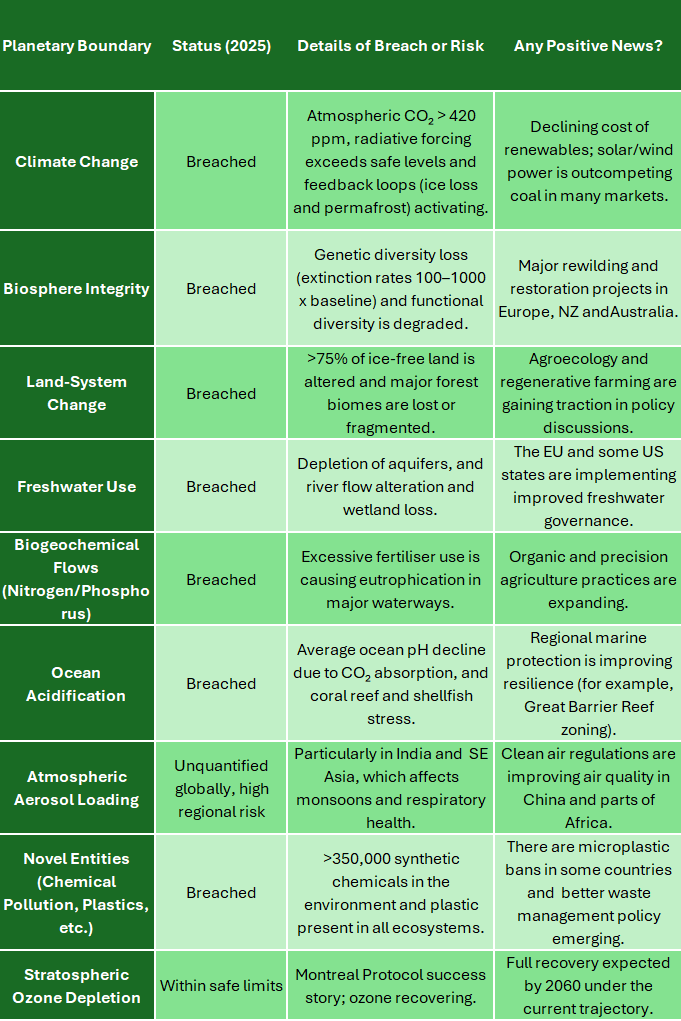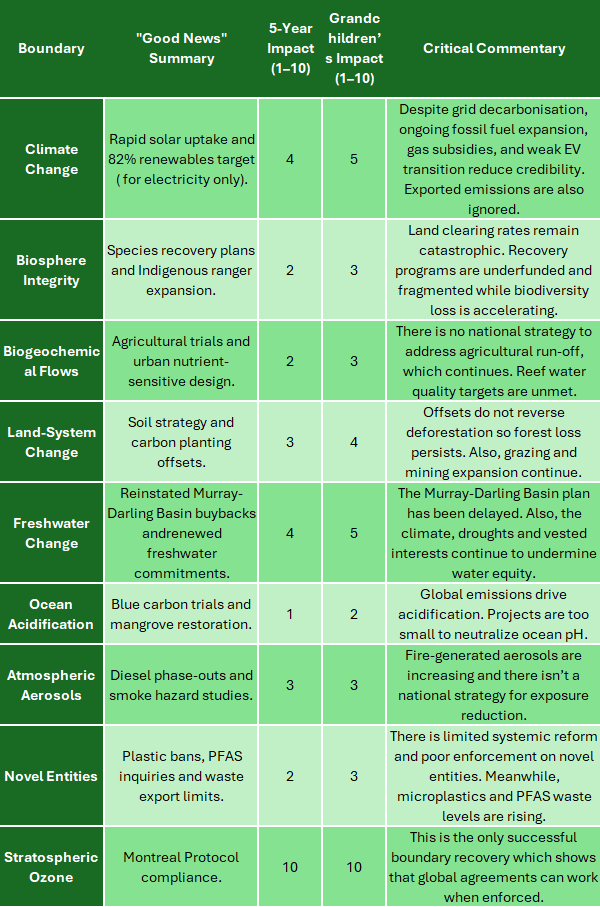2025 Planetary Boundaries summary
Global Boundaries
Here’s a primer on this topic and an update on what is happening here in Australia.
Table 1 Planetary Boundaries
Critical assessment of Australia’s planetary boundary responses
Upon examination of an earlier assessment (unpublished), it is now clear that the
so-called “good news” regarding Australia’s planetary boundary performance is mostly aspirational or marginal. Without systemic change in land use, fossil fuel policy and economic priorities, these improvements are unlikely to prevent further harms to Earth’s safe operating space.
This revised assessment reflects a more realistic and critical appraisal. While
small-scale initiatives exist in each domain, most are underfunded, inconsistently implemented, or contradicted by other policies.
If, as is often stated, the best predictor of future behaviour is past behaviour, then this moderately realistic summary may still be too optimistic. Based on policy trends and scientific risk evaluation, the likelihood that Australia will stay within safe ecological limits without radical transformation is estimated at less than 20%.
Therefore, the future is not looking rosy without significant action, and that actions starts with us.
Table 2: Planetary boundaries and Australia
What can we do?
If the breach of planetary boundaries is the result of extractive systems and disconnection — from nature, each other and future generations — then the way forward must involve improved relationships, renewed responsibility, and meaningful action on eco-regeneration. While government commitments are critical, individuals and local groups are not powerless.
How individuals can help
Even in the face of global crises, individual choices matter - not just for carbon reduction, but for shifting cultural norms, supporting regenerative systems, and deepening our ecological identity.
Practical actions:
Rewild your garden, street or school
Planting native species supports insects, birds and ecological resilience. Even balconies and parking strips count.Eat for the planet
Reduce ultra-processed foods and meat products. Choose local, seasonal and low-impact options. Compost food waste or donate to composters.Withdraw support from destructive industries
Shift superannuation and banking to ethical funds. Reduce consumption. Repair and reuse.Stand up for ecosystems and justice
Support campaigns, write to MPs, volunteer with Landcare Australia or regenerative farming groups. Disrupt denial with courage and compassion.Rebuild community
Host a meal. Start a repair cafe. Learn names of your neighbours. Planetary restoration depends on social resilience.Practise mindful presence and sacred attention
Nature connection, silence and contemplative rituals restore inner orientation. They build what Thomas Berry called “a communion with Earth.”
How MANA can help
MANA is uniquely placed to model and mobilise community-scale responses that integrate nature, mindfulness and systems change. Our approach can align with the boundaries framework by attending to the root causes of overshoot: disconnection, speed and consumption.
MANA’s contribution includes:
Local nature restoration projects
Partner with councils, First Nations groups and landholders to protect and replant native habitat corridors, prioritising insect and fungal biodiversity.Expand ‘Natural Mindfulness’ and Nature Bathing
Scale training and public programs to help thousands reconnect with land, slowness and connection in parks, bushland and beaches.Host planetary awareness events
Days of Mindfulness and seasonal festivals can address planetary health, ecological grief, hope and adaptive living.Develop citizen education programs
Create accessible content (videos, workshops and infographics) on planetary boundaries, regenerative living and spiritual ecology.Foster a kinship economy
Support local food production and sharing, tool-sharing, crafts and eco-businesses through directories and slow economy partnerships.Policy and advocacy from the margins
Publish articles and submissions that elevate grounded voices — ecologists, carers, farmers, and youth — and push for systems change.Work with thresholds, not ideals
Teach about planetary boundaries as real-world thresholds that must not be exceeded — not simply abstract ideals. This realism fosters ethical courage.
A final word
We are living in what environmental activist Joanna Macy calls the Great Turning, a time when the old industrial growth society is collapsing and the seeds of a life-sustaining culture are sprouting. What happens next depends not on abstract optimism, but on “embodied response, relational repair, and loving defiance”.
If Australia is to find its place within the planetary household, it will not be through consumption with a greener brand, but through grounded kinship, community actionand spiritual courage. MANA is here to help that unfold.
References
Bradshaw, C. J. A., Ehrlich, P. R., Beattie, A., Ceballos, G., Crist, E., Diamond, J., Dirzo, R., Ehrlich, A. H., Harte, J., Harcourt, A. H., Pyke, G., Raven, P. H., Ripple, W. J., Saltré, F., Turnbull, I., Wackernagel, M., & Blumstein, D. T. (2021). Underestimating the challenges of avoiding a ghastly future. Frontiers in Conservation Science, 1, 615419. https://doi.org/10.3389/fcosc.2020.615419
Garnaut, R. (2022). Superpower: Australia’s low-carbon opportunity. Black Inc.
Hughes, L., Quicke, A., & Hanna, E. (2023). Australia’s fossil fuel dependence. Climate Council. https://www.climatecouncil.org.au/resources/fossil-fuel-dependence-australia/
IPCC. (2023). *Climate Change 2023: Synthesis Report*. Intergovernmental Panel on Climate Change. https://www.ipcc.ch/report/ar6/syr/
Persson, L., Carney Almroth, B. M., Collins, C. D., Cornell, S. E., de Wit, C. A., Diamond, M. L., ... & Villarrubia-Gómez, P. (2022). Outside the safe operating space of the planetary boundary for novel entities. *Environmental Science & Technology*, 56(3), 1510–1521. https://doi.org/10.1021/acs.est.1c04158
Richardson, K., Steffen, W., & Liverman, D. (2018). Developing a planetary boundaries framework. *Annual Review of Environment and Resources*, 43(1), 27–50. https://doi.org/10.1146/annurev-environ-102017-025921
Rickards, L., & Howden, M. (2020). Critical uncertainties in climate adaptation planning. Environmental Research Letters, 15(9), 093006. https://doi.org/10.1088/1748-9326/ab9c4c
Rockström, J., Steffen, W., Noone, K., Persson, Å., Chapin III, F. S., Lambin, E., ... & Foley, J. (2009). A safe operating space for humanity. *Nature*, 461(7263), 472–475. https://doi.org/10.1038/461472a
Rockström, J., Gupta, J., Lenton, T. M., Qin, D., Lade, S. J., Abrams, J. F., Bai, X., Bringezu, S., Crépin, A.-S., De Vries, W., Galaz, V., Gaffney, O., Gerten, D., Grinevald, J., Haines, A., Hsu, A., Kanie, N., Leach, M., Luchenco, J., ... Wang-Erlandsson, L. (2023). Safe and just Earth system boundaries. Nature, 619, 458–468. https://doi.org/10.1038/s41586-023-06083-8
Steffen, W., Richardson, K., Rockström, J., Cornell, S. E., Fetzer, I., Bennett, E. M., Biggs, R., Carpenter, S. R., De Vries, W., De Wit, C. A., Folke, C., Gerten, D., Heinke, J., Mace, G. M., Persson, L. M., Ramanathan, V., Reyers, B., & Sörlin, S. (2015). Planetary boundaries: Guiding human development on a changing planet. Science, 347(6223), 1259855. https://doi.org/10.1126/science.1259855
Steffen, W., et al. (2023). Earth beyond six of nine planetary boundaries. *Science Advances*, 9(37), eadh2458. https://doi.org/10.1126/sciadv.adh2458
UNEP. (2023). *Global Environment Outlook 7 (Draft Summary)*. United Nations Environment Programme.
Wang-Erlandsson, L., Fetzer, I., Keys, P. W., Rockström, J., & Gordon, L. J. (2022). A planetary boundary for green water. *Nature Reviews Earth & Environment*, 3(6), 380–392. https://doi.org/10.1038/s43017-022-00287-8


